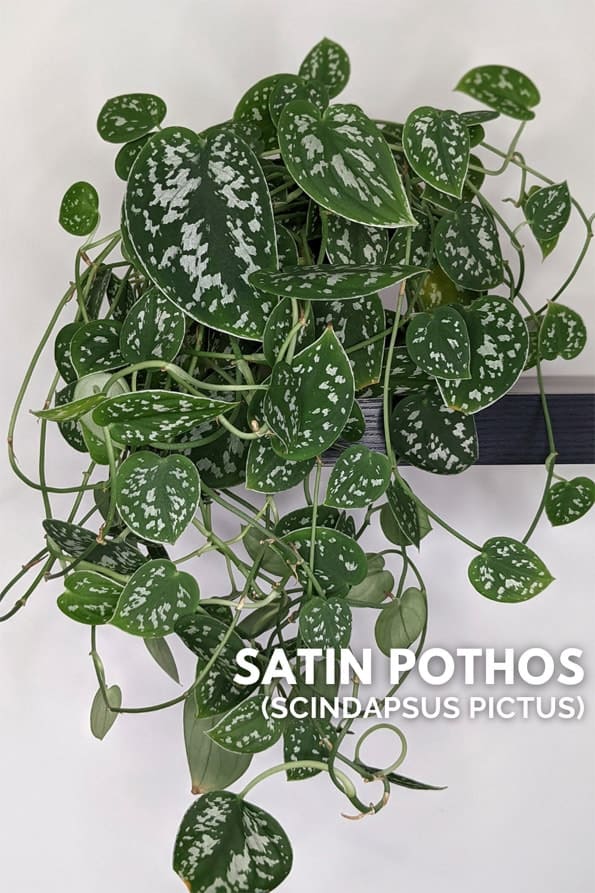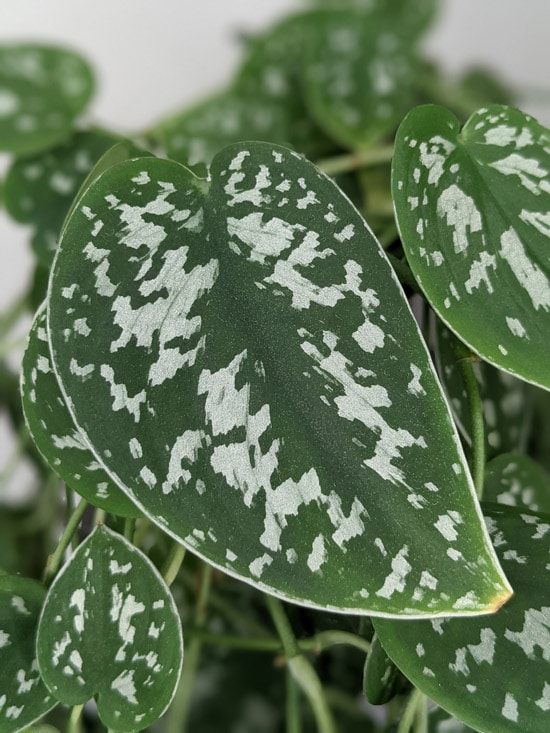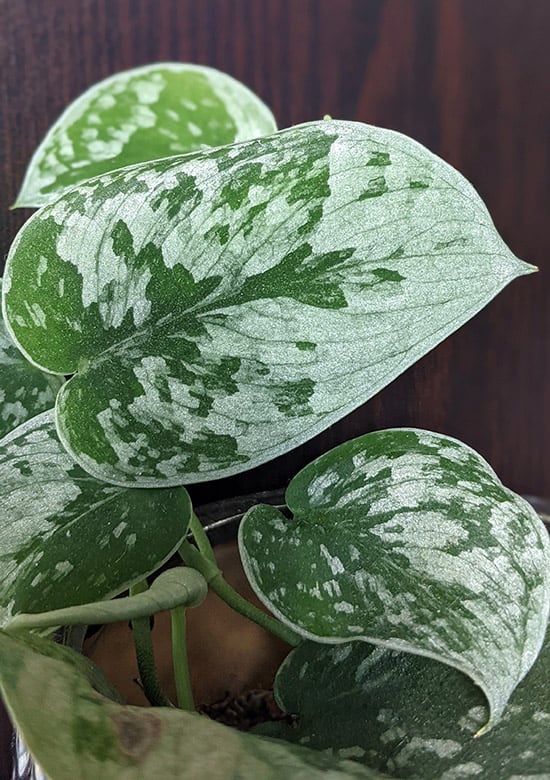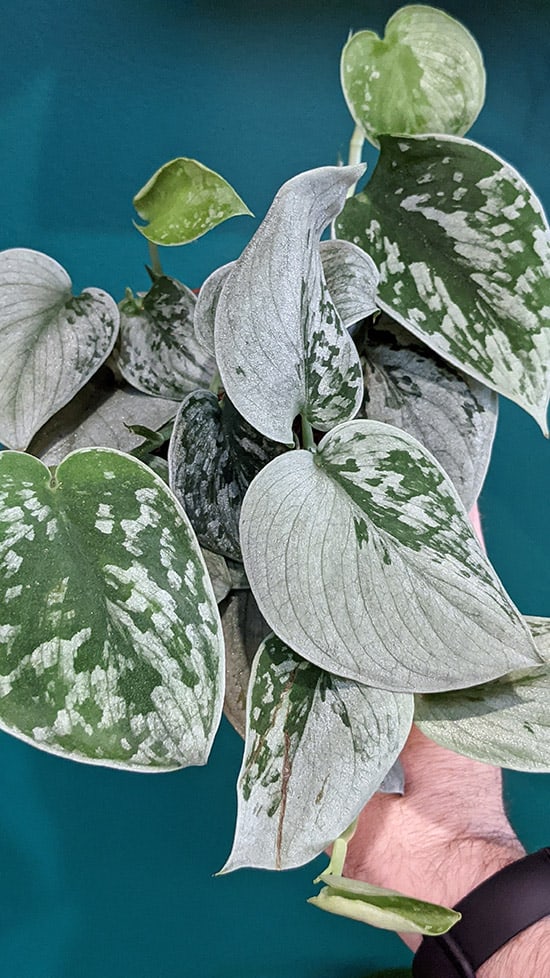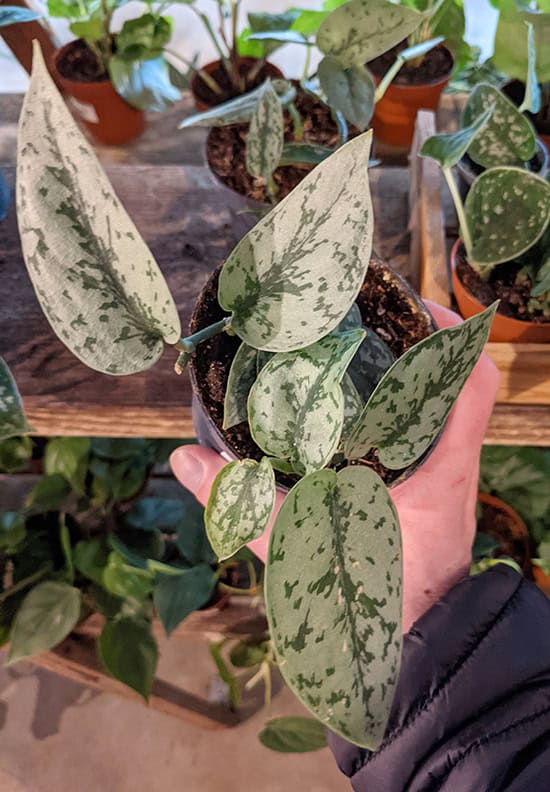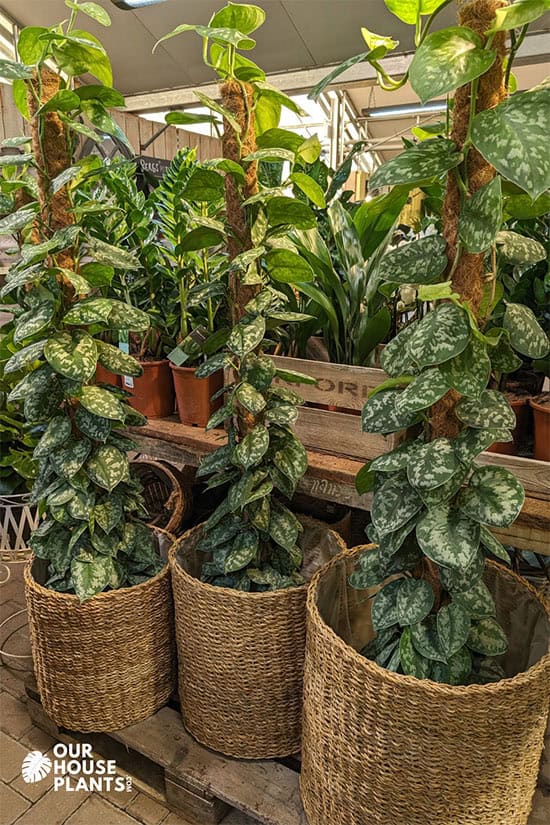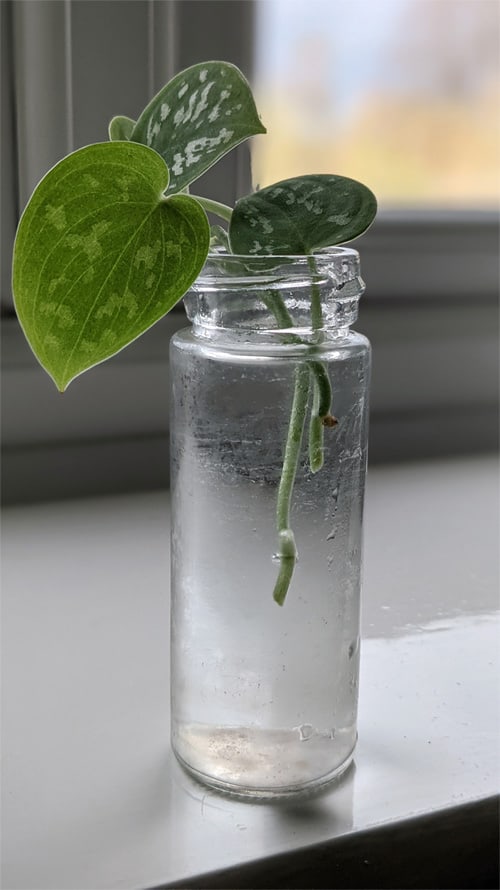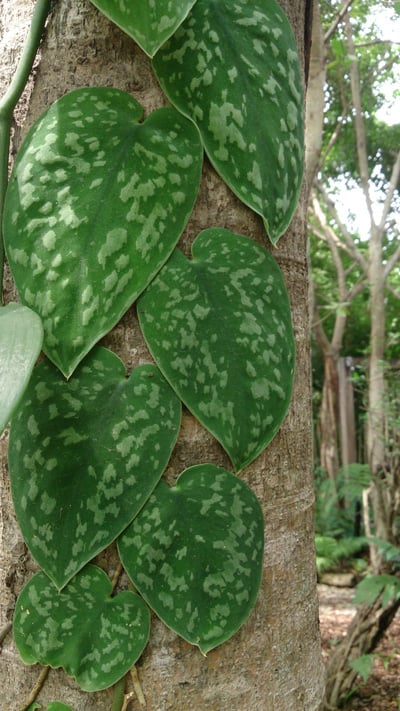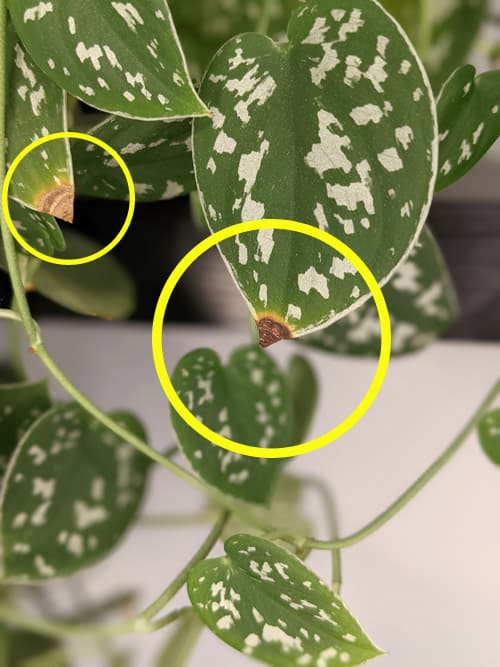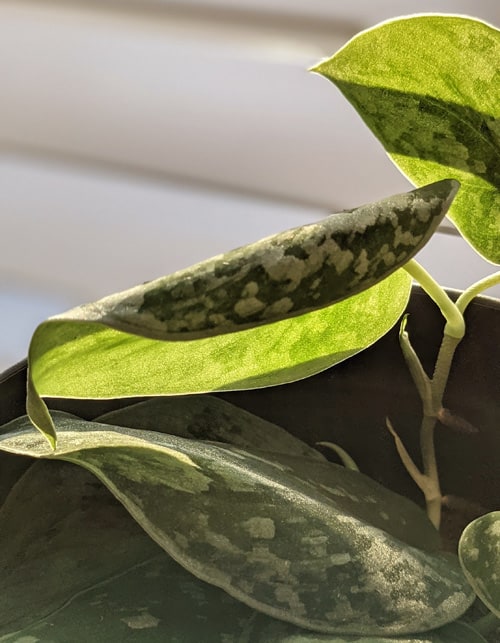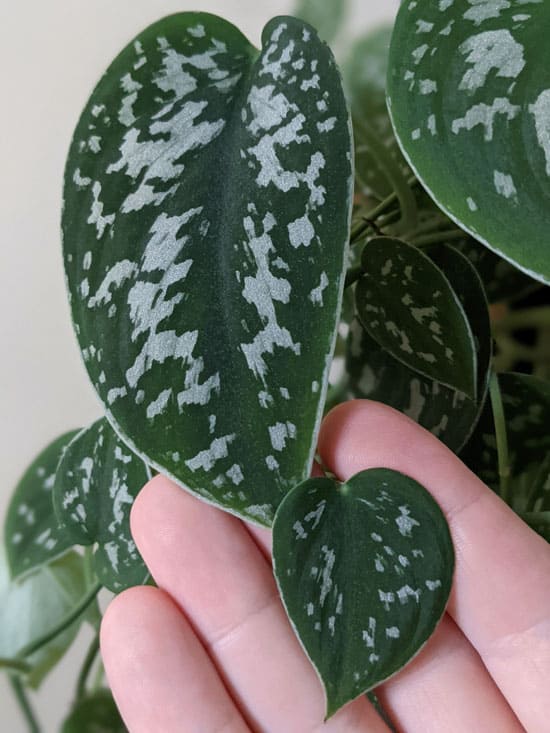Scindapsus pictus usually goes by the common names of Satin Pothos or Silver Vine. It has beautiful firm matte green leaves covered in slightly reflective silver blotches that shimmer and catch your eye in the right light. The leaf edges are outlined in a thin line of silver too. Gorgeous.
Maybe you're thinking these good looks must mean lots of effort? If so, you're wrong.
They're pretty easygoing and adaptable plants, dealing with some sun and also moderate shade. This is a houseplant that's both easy and a joy to own.
A glamorous Scindapsus pictus plant, showing off its silver markings.
Most Scindapsus pictus look like Epipremnum Aureum (Pothos) plants and the Satin Pothos with the heart shaped leaves and root climbing vines is no exception.
How do you pronounce Scindapsus pictus correctly? Say:
Sin-Dap-Cis Pik-TUS
Scindapsus pictus is normally called the "Silver Pothos", or "Satin Pothos" which confuses things even more because it's not actually a "Pothos". They're not even the same species, more like very closely related cousins. The care requirements are almost the same though.
This is one of the more straightforward indoor plants you can own in terms of care needs. In five years of owning mine, they've never had insect pests and maintenance has just consisted of removing the occasional yellow leaf.
Just to be clear
Scindapsus is a Genus of at least 35 plants, several of which are grown as houseplants (like the unusual but popular Scindapsus treubii). The focus of this article is Scindapsus Pictus, just one of the 35 Scindapsus Species.
You can grow it in different ways and there are a number of exciting varieties on offer. I wouldn't say it's an expensive or rare plant, but some of the cultivars are relatively hard to find and these can push up the prices.
There are around five common Scindapsus Pictus varieties and cultivars. Most of them have very similar looks with the main differences being the amount or placement of the silver blotches on the leaves.
There are more than five cultivars though, but as of 2024, the others are still uncommon. So I'm not going to cover them here, otherwise we'll be here all day!
Scindapsus pictus 'Argyraeus' showing off its silver variegation.
Scindapsus pictus 'Argyraeus'.
Potentially the "original" plant and almost certainly the first to be sold commercially on mass to the public (pictured above). I'd argue it's the most common (and cheapest) variety you'll find in shops or from online sellers.
It can have different leaf sizes, but they all have a similar shape with most of the leaves being dark green. It then has splashes of silver throughout each leaf with a narrow continuous silver leaf edge.
The Royal Horticultural Society (RHS) liked it so much that they gave it their Award of Garden Merit.
Scindapsus Pictus 'Silvery Ann'.
Harder to come by and full sized plants can be expensive. Cuttings with one or two leaves attached are common from sellers on Etsy and eBay. If you're searching for one, it's sometimes spelt as "Silvery Anne".
It grows slower than the 'Argyraeus' (which might account for some of its rarity), and its leaves have significantly more silver and less green, sometimes taking up large solid sections of the leaf.
'Silvery Ann'
Scindapsus Pictus 'Exotica'.
Also going by the name 'Trebie', it usually has much larger and lighter leaves. There can be less silver coloring on some of the foliage than what you'll get on the 'Silvery Ann', but still more than what you find on the 'Argyraeus'.
The silver is often more spread out and there are less solid sections. That said, some leaves can be almost fully silver, so it's quite a variable plant. The main difference are the bigger leaves, side by side with other varieties, they can be almost double the size at times. The result is an unusual look that distinguishes it from the previous two varieties.
'Exotica' / 'Trebie'.
Scindapsus Pictus 'Silver Lady'.
The markings on the Silver Lady, are more organised and appealing to the eye (at least to mine). There is more rhythm and symmetry in the variegation which I love. The leaves are more ridged and are harder to bend and fold.
Overall it feels like a sturdier plant. Unfortunately, it's often rarer and a little more expensive than the other varieties I've talked about. If you really like it, then you may have to go online.
'Silver Lady'
Scindapsus Pictus 'Jade Satin'.
This is a weird one, it doesn't look like a "Satin Pothos" at all! The leaves are bigger again (same shape though) but this time there are no silver markings at all. The leaves are "jade" colored.
It's certainly an outlier compared to the others and this perhaps makes it less exciting, but it has some very devoted fans.
It's pretty rare still, so for now it could be down to these eBay sellers if you really want one. (This is an affiliate link and ourhouseplants.com does not endorse the sellers. Make sure you research the seller before making a purchase).

Hi, I'm Tom!
If you're like me and enjoy the challenge of growing houseplants and getting them to thrive, then Ourhouseplants can help. This website shares my knowledge and years of growing plants and provides (hopefully) helpful advice on properly caring for your indoor plant friends.
Truly a versatile plant when it comes to light levels. They can deal with direct sunlight in a South facing window if given some protection and adjustment time (don't suddenly move it from a dark location to one with full, intense Summer sun).
They can also do surprisingly well in some low light spots providing you take care not to over water your plant. For example, one of mine grows on a shelf towards the ceiling and around 6 feet away from a North-West window.
If you choose a low light location, you shouldn't expect lots of new growth over the growing season. Plants growing in brighter spots will grow considerably more.
Did you know?
"Scindapsus" comes from the Greek word "skindapsos" meaning an ivy-like plant. Whereas "Pictus" is Latin and means "having been painted" in respect of the silver leaf markings.
They're not overly thirsty and can deal with some drought if it happens. They'll be happiest if you let around half or two thirds of the potting soil fully dry out before you water them again.
Overwatering is the biggest issue for these houseplants. It's very easy to overdo it and excessive watering will cause root rot. Either make sure excess water can escape from a drainage hole or tilt the pot shortly after watering to drain out anything that's not been absorbed.
Mild overwatering regularly will cause brown leaf tips, normally with a slight yellow line between the brown ends and the healthy green of the leaf.
If allowed to climb up a support structure like a moss pole, they'll become tall plants after a few years.
I've seen that many other owners will recommend high humidity levels as essential. Because Satin Pothos is a tropical plant from Southeast Asia, I suspect it would prefer higher humidity levels if given a choice. But I want to let you know that in my personal experience, they don't appear to be phased by what they get.
My home can have quite variable levels throughout the year and these plants have consistently grown without any problems.
What I'm saying here is, yes sure, aim for higher levels if you want, but don't fret if this isn't something you can achieve easily. Your plant isn't going to hold it against you.
Even if you grow it somewhere with lots of light, warm temperatures and the perfect amount of watering, they don't grow particularly fast. This means they're not heavy feeders and they'll be happy if you give them a balanced water based fertilizer every month or two.
Seriously, there is no point giving feed more frequently than this. The plant won't use all the nutrients you're adding and so you're just wasting your money and risking fertilizer burn or mineral salts building up in the growing medium.
Warm temperatures are needed for these tropical plants as they don't like cold temperatures at all. Try to grow it somewhere all year round with a temperature range between 15°C (59°F) and 25°C (77°F).
It could easily take a few years before the roots have filled an entire pot. Once this has happened and you can see a lot of roots coming out of the drainage holes feel free to repot your plant into a larger pot.
You'll never have to repot urgently though. These plants will cope with cramped conditions for ages before showing any problem signs.
An open and light growing medium with good drainage is ideal. Peat based would be OK, but if you're conscious about your carbon footprint, or want to try something new, I recommend coconut coir.
I was skeptical about it initially, but I've been using it in my soil mixes for the last year, and it's great stuff. Easy to use and all my plants have been fine.
It's particularly suited to Satin Pothos plants because they don't like excessive water around the roots which can cause soggy soil. And unlike peat, coconut coir doesn't compress down over time, helping to keep everything open and free draining.
You can easily propagate more plants through stem cuttings. The process is fast and if you take several cuttings and put them in the same pot you can have a good looking plant in less than six months.
The first step is to find the ends of the vine / stem and then cut above a leaf node with sharp scissors. These nodes will run along the entire stem, appearing every 5cm (2.5in) - 10cm (5in), so there should be at least one or two towards the end of the vine you'll be cutting.
Once you have the cuttings in water, put them somewhere in bright light out of full sun.
You only need a couple of leaves at the end, so the cutting doesn't have to be long at all. Once you have a few cuttings, just pop the ends into a vase or jar of water. The node must be submerged, and the leaves stay above the water, as shown in the photo above.
Top Tip
Put a few cuttings into the same pot to get a fuller plant quicker.
Put the vase / jar somewhere warm with bright indirect light. It's important to avoid low light and direct sunlight at this stage because it could prevent the cuttings from growing. The roots should start to form at the node within a few weeks. Once they've grown a few inches long, you can move them into your potting mix. That's it. Super simple.
Hopefully, that made sense, but if you need to see more, including where to cut the stems and clear pictures of a leaf node, then watch my YouTube video below.
Watch our super short YouTube video if you want a visual propagation guide.
Relatively speaking this plant is a slow grower. Yes for sure if you have an adventurous vine that's shingling and growing up a wall or plank of flat wood (see below), it's going to climb upwards and push out new leaves as it goes in a very obvious way.
All that climbing can look quite dramatic and gives the impression it's a fast grower, but most varieties have smallish leaves and it takes a long time before its footprint increases massively.
Most Scindapsus will have one main stem / vine that creeps along with a new leaf popping out every few inches. It's usual to buy a pot with several stems within the same container, quickly giving a "full" look. Given time these stems can easily reach several meters.
You can keep the plant "compact" and full looking by draping the stems back into the heart of the plant and letting them cascade down a little. You can also clip off the ends when they get too adventurous. This I would say is the most common way people grow these plants.
However you can let them climb instead. In their natural habit they grow upwards, rather than trail down. So if you let them, they will attach and "shingle" up a textured surface.
Whether this is a moss pole or a piece of wood, the plant will produce little aerial roots from the nodes on the stem that help anchor and grip onto the surface as it climbs up.
Plants that are allowed to climb or "shingle" up a surface, like this one, tend to produce larger leaves. - Photo by Mokkie
Mature plants in high light can occasionally grow fairly basic looking flowers. They aren't going to outdo the leaf patterns, but it's still nice to see from time to time.
Satin Pothos can give a painful and swollen mouth to anything or anyone that tries to eat it. This is caused by the microscopic needle-shaped calcium oxalate crystals within the plant's tissues.
It's not likely to cause any serious or long term problems, but as with all our warnings, if your pets or kids are known to eat or nibble plants you're better off growing it in a spot they can't reach. Perhaps in a hanging basket high up.
If you're letting your plant grow long and trail freely, it can look a little untidy over time. To keep it compact, neat and "fuller", you can either cut off the growing tips (and propagate new plants), or just drape the vines back up towards the heart of the plant.
Use the slider below to see the difference and why a trained trailing plant will look better.
Use the slider above to tap / swipe back and forth to see the difference a little draping and wrapping can make to the look of your Silver Pothos.
Silver Satin Pothos with brown leaf tips. Sometimes caused by the relative humidity being too low.
Brown tips are probably the most common problem owners will come across. They are usually caused by one of the following.
Leaves Curling.
The leaves sometimes curl in intense heat, but you're more likely to see this when the plant needs watering (underwatering).
This is usually a good indication of underwatering.
When the growing medium has fully dried out, the leaves attempt to conserve what little water remains and curl backward. Water your plant well and the leaves will fully uncurl over the next 24 hours.
Yellow Leaves.
A few things could cause this.
Pests.
As I've mentioned before, I've never had any type of pest pressure on my Scindapsus plants. They all seem to resist insects well (or maybe they just don't taste nice!).
However I have heard from people who have had issues with Spider Mites. This is usually a problem in low humidity homes and workplaces and they can be hard work to get rid of. If you're prone to Spider Mites the best solution is to try and grow them in average to high humidity areas to deter them in the first place.
Satin Pothos has small leaves.
Brand new leaves will always be small to start with, but they normally get bigger over a month or so. However if the growing stem grows on and a new leaf pops out but the previous one is still small, then that's a potential problem.
On a mature plant, too little light can be a reason for smaller leaves.
The main reason for new leaves being smaller than older leaves is it's not getting enough light. Small leaves aren't always a "problem" as a big part of it comes down to aesthetics. However, if you want bigger leaves try moving it to a brighter spot.
If you've done that and new leaves are still small, it could be due to lack of feed, or a sign your plant needs repotting.
Keeping the soil "moist" constantly can cause problems, but you'll typically avoid root rot. But when the plant has been overwatered excessively and there is water swirling around the roots, that's when root rot can occur. The entire plant will fall over and be very droopy if this takes hold.
If you tilt the pot sideways you'll probably get water pouring out. Drain as much as you can, move to a warm spot to try and help the growing medium to dry out and then it's a case of hoping for the best.
In all likelihood it might be the end of the road for your plant, so it could be worth taking stem cuttings and trying to propagate replacement plants.
For the longest time, I always thought this was a typical "Pothos". Totally wrong. Whoops. With a similar growth habit, look and name it's easy to see why though.
They're related, but based on current classifications they're "cousins" at best. Here is some more information if you want to learn more about the differences between the Epipremnum and Scindapsus genus.
I treat it the same as my other regular Pothos varieties as the care requirements are pretty much the same between the two. Although one thing I did notice early on, was that Satin Pothos seems to be slower growing in comparison to the regular Pothos. But its wonderful leaves more than made up for that. They stand out more and the leaves are slightly thicker and firmer. I love that.
For the longest time I always thought this was a typical "Pothos". Whoops.
It's a straightforward plant that you can just dish out only moderate care to every now and again and everything still looks handsome and orderly (with a little training).
The Satin Pothos is a forgiving indoor plant and could be a fab choice for a newbie who wants to get their feet wet with something exotic looking.
